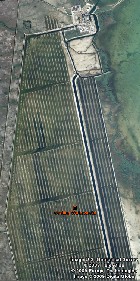| |
l
FL water rules tread water (09/12/2012)
l
Back on path to protect a treasure (06/16/2012)
l
Everglades clean-up approved (06/15/2012)
l
EPA OKs $880M Everglades clean-up (06/14/2012)
Polluters' propaganda is wrong
News-Press.com: Dec. 14, 2010 (abbreviated):
Re: "New EPA water standards are costly and based on bad science," Barney Bishop, Dec. 2. Billions of dollars may well be lost if Mr. Barney Bishop (CEO of Associated Industries of Florida) and his vocal, influential minority are successful in their fear-mongering strategy to prevent implementation of the plans to improve the water quality of Florida's waterways. Industry sacrifices waters' future to short-term profits.
Those who profit the most from the current, old-fashioned system of short-term economic growth must adjust.
In a recent poll, over 80 percent of Floridians indicated they wanted improvements to water quality. The silent majority seems to realize that the sustainable economies for Florida (agriculture, fishing and tourism) require clean and healthy water systems.
Mr. Bishop's remark about algae blooms being natural is superficial and absurd. Nutrient input from humans has been demonstrated to faul our waters.
Since industry influences the political appointments by elected leaders, the agencies have bowed to these pressures.
It would be more appropriate to shift the responsibility of cleanup costs for improving water quality back to the polluters instead of the tax-payers.
The natural waters of Florida should not continue to serve as the cesspools for industry.
I hope the residents of Florida are not gullible enough to allow it.
Our ability to thrive and prosper on the planet requires implementation of more sustainable practices. I hope other leaders of industry are willing to step up and do what is right.
l
Playing politics - Florida's water -Dec.9/10
l
Earthjustice blasts lawsuit against EPA -1208
l
Florida sues EPA over water rules -1207
l
New EPA standards - bad science ? -1202
l
EPA and SFWMD head-to-head -1130
l
EPA rules for FL long overdue -1121
l
The Cost Of Cleanup
l
EPA delaying new rules
l
EPA-FL water war
Tamiami Trail Bridge
to be expanded - new $$: Everglades Summit 2010
In MAY'10, the government is recommending another 5.5 miles be elevated to improve the flow of surface water. Money for the $330 million dollar project has yet to be authorized by Congress, but Secretary Salazar already committed $360 million in economic stimulus money and promised another $278 million in 2010.
In December 2009, with an infusion of federal funding, the project to elevate a mile of the roadway finally broke ground.
BRIDGE START in 12/09:
BRIDGE APPROVED 9/09:
Everglades to get water relief from $81 mln bridge
Reuters: Sep. 29, 2009
The U.S. Army Corps of Engineers awarded an $81 million contract to Kiewit Southern Company of Sunrise, FL. They are to remove 1 mile of the Tamiami Trail road that crosses the park and blocks natural water flows to the northeastern Everglades - and replace it with the bridge. "Tamiami Trail currently acts as a dam that starves the Park of its lifeblood -- water," said Dan Kimball, superintendent of Everglades NP.
» Read more - -
Lake Okeechobee Pollution Levels Spike Out of Control
CommonDreams.org: Sep.23, 2009
Current phosphorus pollutant levels are "approximately 4 times" the legal maximum level according to U.S. Environmental Protection Agency figures jointly released today.. "There is a 300 square mile ‘muck zone' on the bottom of Lake Okeechobee containing 30,000 tons of phosphorus for which there is no clean-up plan".
» Read more - -
» Also in the BLOG with Bo-
Federal
stimulus money - -
July 7, 2009
-
- is paying for more than roads and bridges
during this economic downturn. Ecological projects are part of the
mix -- and that bodes well for Florida. Using stimulus dollars to
conserve resources that generate millions of tourist dollars also
contributes to our food and water supplies and generates jobs.
....
»
Read more
 Read up on projects
Read up on projects
|
|
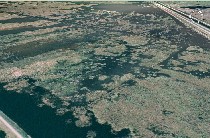
Abandoned Reservoir A-1 project. More than $270-million "moonscape".
It is supposed to get used in the future - redesigned as a FEB (Flow Equalization Basin)
 A-1 Reservoir Construction to Begin - to Improve Everglades Water Quality
(SFWMD Press Release, October 10, 2013)
A-1 Reservoir Construction to Begin - to Improve Everglades Water Quality
(SFWMD Press Release, October 10, 2013)
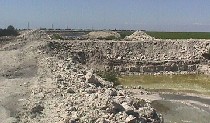
 Reviving stalled Everglades reservoir raises homes and cost questions (Sun Sentinel, March 2, 2013)
Reviving stalled Everglades reservoir raises homes and cost questions (Sun Sentinel, March 2, 2013)

 |
Controversial
- 1 mile finished
- Expansion considered |
| Tamiami Trail Bridging : |

Tamiami Trail as it has been for decades (above) - and below is as it may look like in
a few years. The new 1-mile long bridging
has opened for traffic in March 2013.
US-DOI even offered a preferred extended version - 6.5 miles bridging - but backed off. Now it is quite uncertain just how long a bridge there will eventually be.

 |
Controversial
- Some land bought
- Which to swap ? |
|
Land Swap : |

Agricultural land has been bought off, mainly South of Lake Okeechobee in the Everglades Agricultural Area. However, the land parcels are discontinuous. When consolidated, the land is eventually to be replaced by water-cleansing wetlands :

 |
Controversial
- Critically polluted !
- Dike & South floway ? |
| Lake Okeechobee : |
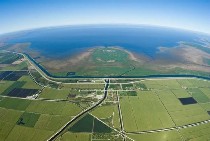
Lake Okeechobee is just loaded with polluting Phosphorus ! The adjacent Everglades
Agricultural Area keeps running off more of it - in all directions. Part of it is the subject of the recent controversial land purchase
deal (from US Sugar Co.).
Brady Ranch land at Lake Okeechobee (below) for the STA wetland construction :
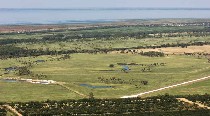
 |
Controversial
- Pits as reservoirs ?
- Expansions debated |
| Rock Mining : |

Rock and sand is needed for construction. The mines disturb the shallow aquifers and promote water quality deterioration, dangerous in the vicinity of fresh-water wells and of the Everglades.

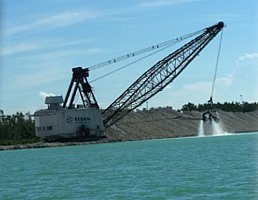
Click for VIDEO:
"Rock Mining"
|
|
 |
Look at where your $$ go :
Look at the A-1 HISTORY -
Can you make sense of these 2 articles ?
|
This is how the original controversy developed - at a huge expense ! |
Reservoir A1
So far, $ 272
million for a
moonscape ? |
Delays, price hikes make a muck of $800 million Everglades project
Palm Beach Post - July
10, 2009 (PAUL
QUINLAN, Staff Writer) - abbreviated article (click HERE for FULL TEXT)
Deep in the cane fields south
of Lake Okeechobee, a massive construction site sits abandoned
along U.S. 27, its dreams for the Everglades
unfulfilled. Bulldozers and earthmovers reduced a vast
swath of these 25 square miles to a gray moonscape of pooled
water and piled rock. This was supposed to have
become the world’s largest free-standing
reservoir.
Officially called the A1 Reservoir, this
environmental Stonehenge carried an $800 million price tag and
big-name endorsements from the likes of Al Gore and Jeb
Bush.
The plan was to build an above-ground lake of
colossal dimensions to feed water into the parched Everglades.
It would be nearly the size of Boca Raton and hold more water
than 100,000 Olympic-size swimming pools. Its 22-mile
perimeter wall would stand three stories tall. Construction
was slated to end next year (2010).
Instead, the project has
become one of the most expensive false starts in the largely
fruitless effort to restore the Everglades, in which the A1
Reservoir was a crucial element.
Two years and $272 million
into construction, the South Florida Water Management District
suddenly ordered work on the reservoir halted in May 2008. Six
months later, water managers canceled construction altogether,
incurring fees and penalties that could add up to another $40
million.
The land may still be used to repair the
Everglades, but much of the money spent can never be
recaptured - for example, $113 million to build a
rock-crushing plant that contractors later dismantled.
The shutdown coincided with
Gov. Charlie Crist’s announcement of an even bolder and
costlier Everglades restoration initiative: a $1.75 billion
state buyout of U.S. Sugar Corp. and its 180,000-acre farming
empire, land perfectly situated to recreate the historic flows
of the Everglades.
Water managers say Crist’s U.S. Sugar
deal, made public in June 2008, did not influence their
decision one month earlier to halt work on the A1 Reservoir. |
But today, officials concede they cannot afford to pay for
both at once, even though Crist has trimmed the U.S. Sugar
deal to $536 million for 73,000 acres.
The land deal will
require scrapping the reservoir plan, as the larger Everglades
restoration blueprint is overhauled to incorporate the new
acreage. It’s worth it, say the governor and his environmental
allies, who view the U.S. Sugar deal as a historic
opportunity.
“I think the benefits of doing better in the
long run far exceed the costs,” said district board member
Shannon Estenoz.
But others question whether the change of
course was worth the extraordinary expense - not to mention
the delay in rescuing an ecosystem on the verge of
collapse.
“What the district has done was to walk away from
the original Everglades restoration plan,” said Mike Collins,
a district board member and critic of the U.S. Sugar deal. “We
were ready to go, and now we’re in limbo.”
The A1 Reservoir
project grew out of its own celebrated land purchase.
In
December 1997, then-Vice President Gore announced that the
state and federal governments would buy out the Talisman Sugar
Corp. The 63,000 acres acquired in the $152 million deal would
be used to store and cleanse billions of gallons of water to
help hydrate the Everglades.
Completed in 1999, it was at
the time the largest single land deal aimed at Everglades
restoration. Years later, the water district carved out a
16,700-acre portion and called it the A1 Reservoir.
The
reservoir was to be a keystone of a 68-piece, $10.9 billion
Everglades restoration plan that Congress passed in 2000. The
deal called for the state and feds to split the costs 50-50,
but bickering between the parties and a lack of money from
Congress ground the restoration to a crawl.
Meanwhile, the jobs that the state had repeatedly boasted
of disappeared. |
|
Money still well spent
Palm Beach Post - Editorial, July 21, 2009
http://www.palmbeachpost.com/opinion/content/opinion/epaper/2009/07/21/a6a_talisman_edit_0722.html
Other similar writings by Eric Buermann, Board Chair of the SFWMD :
"Once-in-a-lifetime chance to restore Everglades" - http://www.evergladeshub.com/news/arch/augTXT.htm#090816
"Investment in Everglades restoration not wasted" - http://www.evergladeshub.com/news/arch/sepTXT.htm#0909253
It’s
hard to throw away as much as $40 million in public money and
call it a cost savings. But that’s essentially what the South
Florida Water Management District is saying about its decision
to halt construction in western Palm Beach County of the
world’s largest above-ground reservoir.
As The Post
reported on July 12, the district stopped construction of the
A1 Reservoir last year at a pivotal point. The district had
spent $272 million preparing the site, particularly by carving
out a 22-mile perimeter. The next stage, at a cost of $330
million, called for building 12-foot-high walls along the
perimeter to turn the former sugar cane field into a humongous
bathtub.
After a lawsuit challenged the U.S. Army Corps of
Engineers permit the district obtained for the project,
district officials stopped work before erecting the walls. If
the permit had been ruled invalid, the district would have had
to dismantle the walls. So, on behalf of the public, the
district swallowed $2 million a month - the total could be as
much as $40 million - in fees to suspend the contract.
One
month later, Gov. Crist announced plans for the water
management district to buy U.S. Sugar in a "show-stopper" deal. It
changed everything about how the A1 Reservoir, on the former
Talisman cane fields, would fit into the new picture of
Everglades restoration. Since then, the district has stopped
the contract on the A1 Reservoir and shelved the
project.
But the completed work is not worthless. It could
prove invaluable.
To preserve the Everglades, the district
needs to store and clean water. With the U.S. Sugar purchase,
the district no longer would need to store water on the
Talisman land because it would be more practical to store
water farther north, next to Lake Okeechobee. Instead of a
reservoir with 12-foot walls, the Talisman lands would be
converted more productively into a marsh that would cleanse
polluted water before it is released into the Everglades. The
construction that has been done could prove useful in creating
the marsh.
Palm Beach County wasted millions by ignoring
lawsuits and starting to build a Scripps Florida campus at
Mecca Farms. The water district came dangerously close to a
similar mistake with the A1 Reservoir, but pulled back before
reaching the point of no return. There may be reason for the
public to be a little frustrated, but there is no reason for
the public to be angry. |
FLORIDA EVERGLADES
- MAJOR CURRENT PROJECTS
and the most Controversial Projects (click for locating photos)
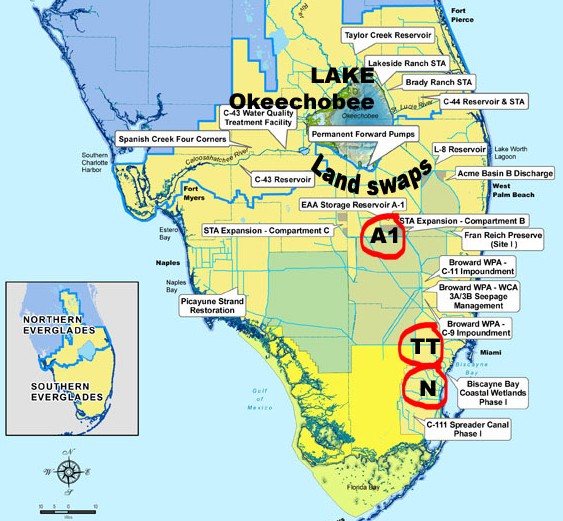
| BIG SUGAR, its AGRICULTURE and LAND
CLICK HERE for special page |
A $ 650 million business
 |
|
| » NEWS - Read more - PRESS - - ( click the link for FULL TEXT by " EvergladesHUB.com " ) |
|
| OFFSHORE OIL DRILLING |
Not quite an "Everglades" business |
|
|
|
|
|
|
|
|




















